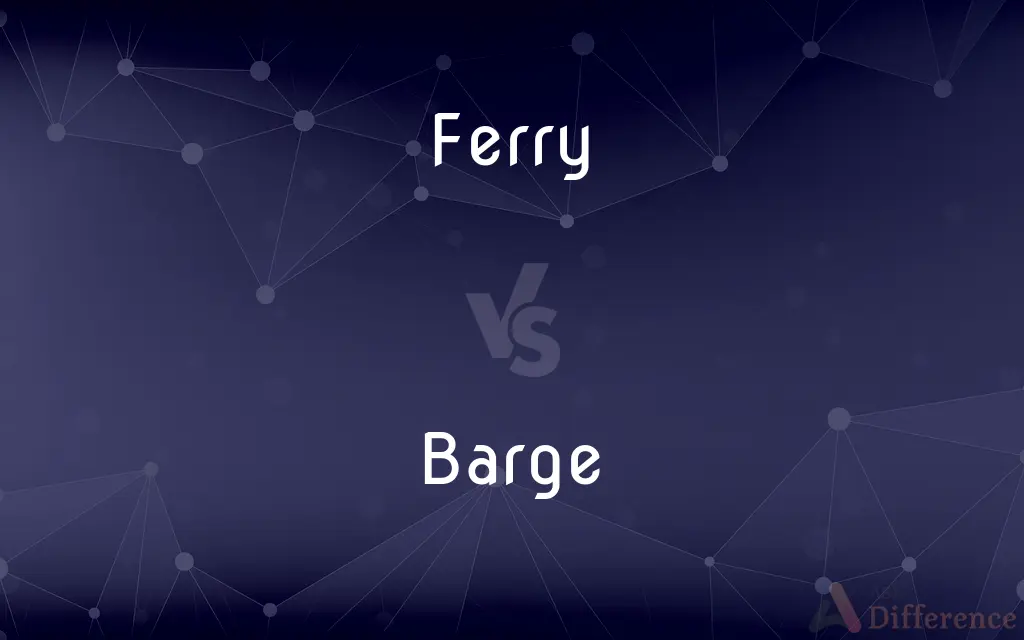Ferry vs. Barge — What's the Difference?
Edited by Tayyaba Rehman — By Fiza Rafique — Updated on March 28, 2024
Ferries are passenger or vehicle transport vessels designed for scheduled services across water bodies, whereas barges are flat-bottomed vessels primarily for transporting goods, often towed or pushed by tugs.

Difference Between Ferry and Barge
Table of Contents
ADVERTISEMENT
Key Differences
Ferries are equipped to carry passengers, vehicles, and sometimes cargo across bodies of water, providing essential links for transportation networks. These vessels are designed for efficiency and speed, often operating on a fixed schedule. In contrast, barges are primarily used for the transportation of heavy goods or bulk cargo along rivers, canals, and coastal routes. Their design focuses on maximizing cargo capacity rather than speed, and they typically require tugboats for navigation.
While ferries are often self-propelled and possess the ability to navigate independently across water bodies, barges usually lack their own means of propulsion and rely on other vessels, such as tugboats, to move them from one location to another. This distinction highlights the operational differences between the two, with ferries providing active transport services and barges serving as passive cargo carriers.
The operational environments of ferries and barges also differ significantly. Ferries commonly operate on open seas, lakes, and large rivers, connecting populated areas, islands, or crossing bodies of water to shorten travel distances. Barges, however, are more frequently found in sheltered waters like rivers, canals, and near-shore areas, where their flat bottoms and shallow drafts are advantageous for navigating shallow waters and docking in undeveloped ports.
Safety and amenities on ferries are tailored to passenger comfort and requirements, including seating areas, restrooms, and sometimes dining and sleeping facilities. Barges, being cargo vessels, lack such amenities and are designed with a focus on cargo efficiency, featuring large, open decks or covered holds for different types of cargo.
Despite these differences, both ferries and barges play crucial roles in transportation. Ferries provide essential connectivity for people and vehicles in many parts of the world, while barges are key to the economical transport of bulk goods, especially in regions where road or rail infrastructure is limited or non-existent.
ADVERTISEMENT
Comparison Chart
Primary Use
Transporting passengers and vehicles
Transporting goods or cargo
Propulsion
Self-propelled
Usually towed or pushed by another vessel
Operating Environment
Open seas, lakes, large rivers
Rivers, canals, near-shore areas
Design Focus
Speed and efficiency for scheduled services
Cargo capacity and stability
Amenities
Seating, restrooms, dining, sometimes sleeping facilities
None, focused on cargo
Compare with Definitions
Ferry
Ferries are vessels that carry passengers and vehicles across water.
The ferry service to the island operates hourly.
Barge
Key components of the inland and coastal cargo transport network.
The barge traffic is vital for the region's industrial supply chain.
Ferry
Ferries vary in size from small boats to large ships.
The new ferry can accommodate hundreds of passengers and their cars.
Barge
Barges are flat-bottomed vessels for transporting bulk goods on waterways.
A barge loaded with coal moved slowly down the river.
Ferry
Some ferries are equipped with amenities like restaurants.
We enjoyed a meal at the ferry's onboard restaurant.
Barge
Barges have a shallow draft, ideal for navigating inland waterways.
The shallow draft allows barges to operate where larger ships cannot.
Ferry
Designed for short-distance travel, often on fixed schedules.
Commuters rely on the early morning ferry to reach the city.
Barge
Used extensively for transporting heavy or bulky cargo.
Grain barges are a common sight along the Mississippi River.
Ferry
Ferries play a key role in connecting communities separated by water.
The island’s main link to the mainland is the ferry service.
Barge
Often towed by tugs, barges are not typically self-propelled.
The tugboat positioned itself to push the barge upstream.
Ferry
A ferry is a vessel used to carry passengers, and sometimes vehicles and cargo, across a body of water. A passenger ferry with many stops, such as in Venice, Italy, is sometimes called a water bus or water taxi.
Barge
A barge is a shoal-draft flat-bottomed boat, built mainly for river and canal transport of bulk goods. Originally barges were towed by draft horses on an adjacent towpath.
Ferry
To transport (people, vehicles, or goods) by boat across a body of water such as a river or bay.
Barge
A long, large, usually flatbottom boat for transporting freight that is generally unpowered and towed or pushed by other craft.
Ferry
To cross (a body of water) by a ferry.
Barge
A large, open pleasure boat used for parties, pageants, or formal ceremonies.
Ferry
To deliver (a vehicle, especially an aircraft) under its own power to its eventual user.
Barge
A powerboat reserved for the use of an admiral.
Ferry
To transport (people or goods) by vehicle, especially by aircraft.
Barge
To carry by barge.
Ferry
To cross a body of water on or as if on a ferry.
Barge
To move about clumsily.
Ferry
To move laterally in a fast-moving river, as in a canoe, by keeping one's boat at an angle to the direction of flow and paddling or rowing against the current.
Barge
To intrude or interrupt, especially rudely
Barged into the meeting.
Ferry
A ferryboat.
Barge
A large flat-bottomed towed or self-propelled boat used mainly for river and canal transport of heavy goods or bulk cargo.
Ferry
A place where passengers or goods are transported across a body of water, such as a river or bay, by a ferryboat.
Barge
A richly decorated ceremonial state vessel propelled by rowers for river processions.
Ferry
A franchise or legal right to operate a ferrying service for a fee.
Barge
A large flat-bottomed coastal trading vessel having a large spritsail and jib-headed topsail, a fore staysail and a very small mizen, and having leeboards instead of a keel.
Ferry
A service and route for delivering an aircraft under its own power to its eventual user.
Barge
One of the boats of a warship having fourteen oars
Ferry
(transitive) To carry; transport; convey.
Trucks plowed through the water to ferry flood victims to safety.
Barge
The wooden disk in which bread or biscuit is placed on a mess table.
Ferry
(transitive) To move someone or something from one place to another, usually repeatedly.
Being a good waiter takes more than the ability to ferry plates of food around a restaurant.
Barge
(US) A double-decked passenger or freight vessel, towed by a steamboat.
Ferry
(transitive) To carry or transport over a contracted body of water, as a river or strait, in a boat or other floating conveyance plying between opposite shores.
Barge
A large omnibus used for excursions.
Ferry
(intransitive) To pass over water in a boat or by ferry.
Barge
To intrude or break through, particularly in an unwelcome or clumsy manner.
Ferry
A ship used to transport people, smaller vehicles and goods from one port to another, usually on a regular schedule.
Barge
(transitive) To push someone.
Ferry
A place where passengers are transported across water in such a ship.
Barge
A pleasure boat; a vessel or boat of state, elegantly furnished and decorated.
Ferry
The legal right or franchise that entitles a corporate body or an individual to operate such a service.
Barge
A large, roomy boat for the conveyance of passengers or goods; as, a ship's barge; a charcoal barge.
Ferry
To carry or transport over a river, strait, or other narrow water, in a boat.
Barge
A large boat used by flag officers.
Ferry
To convey back and forth regularly between two points in a vehicle; as, part of her day was spent ferrying the kids to and from school.
Barge
A double-decked passenger or freight vessel, towed by a steamboat.
Ferry
To pass over water in a boat or by a ferry.
They ferry over this Lethean soundBoth to and fro.
Barge
A large omnibus used for excursions.
Ferry
A place where persons or things are carried across a river, arm of the sea, etc., in a ferryboat.
It can pass the ferry backward into light.
To row me o'er the ferry.
Barge
A flatbottom boat for carrying heavy loads (especially on canals)
Ferry
A vessel in which passengers and goods are conveyed over narrow waters; a ferryboat; a wherry.
Barge
Push one's way;
She barged into the meeting room
Ferry
A franchise or right to maintain a vessel for carrying passengers and freight across a river, bay, etc., charging tolls.
Barge
Transport by barge on a body of water
Ferry
A boat that transports people or vehicles across a body of water and operates on a regular schedule
Ferry
Transport by boat or aircraft
Ferry
Transport from one place to another
Ferry
Transport by ferry
Ferry
Travel by ferry
Common Curiosities
Can barges carry passengers?
While primarily for cargo, some barges may be outfitted to carry passengers, especially on scenic or canal routes.
Why are barges important for cargo transport?
Barges offer an economical and efficient method for transporting bulk goods, especially in areas with limited infrastructure.
What safety measures are in place on ferries?
Ferries are equipped with lifeboats, life jackets, and other safety measures to protect passengers in emergencies.
What distinguishes a ferry from a barge?
Ferries are primarily for transporting passengers and vehicles, often self-propelled, while barges are for cargo, typically towed.
Are all barges flat-bottomed?
Most barges have a flat bottom to maximize stability and cargo capacity, especially in shallow waters.
Can ferries operate in icy waters?
Specialized ice-breaking ferries can operate in icy conditions, providing year-round service in some regions.
Do ferries operate in open ocean?
Some ferries are designed for open-ocean conditions, connecting islands or crossing significant bodies of water.
How fast can ferries travel?
Ferry speeds vary, but they are generally faster than barges, designed to maintain schedules.
Are there electric ferries?
Yes, electric ferries are becoming more common, offering a cleaner alternative to traditional diesel-powered vessels.
How do ferries contribute to transportation?
Ferries provide crucial links across water bodies, reducing travel distances and connecting communities.
Can a ferry be used as a barge?
While their designs differ, ferries may transport cargo, but they lack the cargo capacity and efficiency of dedicated barges.
What types of cargo do barges transport?
Barges can carry a wide variety of cargo, including bulk goods like coal, grain, and petroleum products.
Do barges have engines?
Most barges are unpowered and require tugs or towboats for propulsion, though some self-propelled barges exist.
How does weather affect barge transport?
Severe weather can delay barge operations, especially on open waterways or in areas prone to flooding.
What is the largest type of ferry?
The largest ferries are often ro-ro (roll-on/roll-off) ships, capable of carrying hundreds of vehicles and passengers.
Share Your Discovery

Previous Comparison
Aeon vs. Eon
Next Comparison
Her vs. SheAuthor Spotlight
Written by
Fiza RafiqueFiza Rafique is a skilled content writer at AskDifference.com, where she meticulously refines and enhances written pieces. Drawing from her vast editorial expertise, Fiza ensures clarity, accuracy, and precision in every article. Passionate about language, she continually seeks to elevate the quality of content for readers worldwide.
Edited by
Tayyaba RehmanTayyaba Rehman is a distinguished writer, currently serving as a primary contributor to askdifference.com. As a researcher in semantics and etymology, Tayyaba's passion for the complexity of languages and their distinctions has found a perfect home on the platform. Tayyaba delves into the intricacies of language, distinguishing between commonly confused words and phrases, thereby providing clarity for readers worldwide.














































